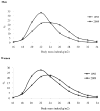Secular trends in the prevalence of general and abdominal obesity among Chinese adults, 1993-2009
- PMID: 22034908
- PMCID: PMC3276709
- DOI: 10.1111/j.1467-789X.2011.00944.x
Secular trends in the prevalence of general and abdominal obesity among Chinese adults, 1993-2009
Abstract
The objective of this study is to examine the trends in body mass index (BMI), waist circumference (WC) and prevalence of overweight (BMI 25-27.49 kg m(-2) ), general obesity (BMI ≥ 27.5 kg m(-2) ) and abdominal obesity (WC ≥ 90 cm for men and ≥80 cm for women) among Chinese adults from 1993 to 2009. Data were obtained from the China Health and Nutrition Survey, which was conducted from 1993 to 2009 and included a total of 52,621 Chinese adults. During the period of 1993-2009, mean BMI values increased by 1.6 kg m(-2) among men and 0.8 kg m(-2) among women; mean WC values increased by 7.0 cm among men and 4.7 cm among women. The prevalence of overweight increased from 8.0 to 17.1% among men (P < 0.001) and from 10.7 to 14.4% among women (P < 0.001); the prevalence of general obesity increased from 2.9 to 11.4% among men (P < 0.001) and from 5.0 to 10.1% among women (P < 0.001); the prevalence of abdominal obesity increased from 8.5 to 27.8% among men (P < 0.001) and from 27.8 to 45.9% among women (P < 0.001). Similar significant trends were observed in nearly all age groups and regions for both men and women. The prevalence of overweight, general obesity and abdominal obesity among Chinese adults has increased greatly during the past 17 years.
© 2011 The Authors. obesity reviews © 2011 International Association for the Study of Obesity.
Conflict of interest statement
The authors declare that they have no conflict of interests.
Figures
References
-
- Dearth-Wesley T, Wang H, Popkin BM. Under- and overnutrition dynamics in Chinese children and adults (1991–2004) Eur J Clin Nutr. 2008;62:1302–1307. - PubMed
-
- Wang Y, Mi J, Shan XY, Wang QJ, Ge KY. Is China facing an obesity epidemic and the consequences? The trends in obesity and chronic disease in China. Int J Obes (Lond) 2007;31:177–188. - PubMed
-
- Janssen I, Shields M, Craig CL, Tremblay MS. Prevalence and secular changes in abdominal obesity in Canadian adolescents and adults, 1981 to 2007–2009. Obes Rev. 2011;12:397–405. - PubMed
-
- Janssen I, Katzmarzyk PT, Ross R. Waist circumference and not body mass index explains obesity-related health risk. Am J Clin Nutr. 2004;79:379–384. - PubMed
-
- Bigaard J, Frederiksen K, Tjønneland A, et al. Waist circumference and body composition in relation to all-cause mortality in middle-aged men and women. Int J Obes (Lond) 2005;29:778–784. - PubMed
Publication types
MeSH terms
Grants and funding
LinkOut - more resources
Full Text Sources
Medical
Molecular Biology Databases
Miscellaneous


